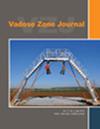Modeling water flow and volumetric water content in a degraded peat comparing unimodal with bimodal porosity and flux with pressure head boundary condition
IF 2.8
3区 地球科学
Q3 ENVIRONMENTAL SCIENCES
引用次数: 0
Abstract
Degraded peatlands release large amounts of greenhouse gases. The development of effective mitigation and management measures requires an understanding of relevant site‐specific biogeochemical and hydraulic processes. However, the simulation of water fluxes and vadose zone state variables of degrading peatlands relies on proper process description, parameterization of hydraulic functions, and representation of the boundary conditions. The objective of this study was to analyze the effects of unimodal versus bimodal soil hydraulic functions and pressure head versus flux‐type lower boundary conditions (LBCs) on the calculated hydraulic characteristics of a degraded peat profile. HYDRUS‐1D was used to study the hydraulic flow dynamics parameterized with data from a weighable groundwater lysimeter for the period from May 1 to December 31, 2019. Simulations comparing uni‐ and bimodal hydraulic functions showed only minor differences. Simulations of soil water pressure at a depth of 30 cm using a flux‐type LBC (RMSE: 27 cm, where RMSE is root mean square error) performed better than simulations using a pressure head LBC (RMSE: 48 cm). The pressure head LBC performed better at simulating volumetric water contents in 30‐cm depth than the flux LBC variant (RMSE: 0.05 vs. 0.09 cm模拟退化泥炭中的水流和体积含水量,比较单模态和双模态孔隙度以及带有压头边界条件的通量
退化的泥炭地会释放大量温室气体。要制定有效的缓解和管理措施,就必须了解相关地点的生物地球化学和水文过程。然而,模拟退化泥炭地的水通量和软弱带状态变量依赖于正确的过程描述、水力函数参数化和边界条件表示。本研究的目的是分析单模态与双模态土壤水力函数、压头与通量型下边界条件(LBC)对退化泥炭剖面计算水力特征的影响。使用 HYDRUS-1D 研究了 2019 年 5 月 1 日至 12 月 31 日期间的水流动力学参数,参数采用的是可称重地下水渗滤仪的数据。单模态和双模态水力函数的模拟比较仅显示出微小差异。使用通量型 LBC(均方根误差:27 厘米,RMSE 为均方根误差)模拟 30 厘米深度的土壤水压力,比使用压力水头 LBC(均方根误差:48 厘米)模拟的结果更好。在模拟 30 厘米深度的体积含水量方面,压头 LBC 比通量 LBC 变体(均方根误差:0.05 对 0.09 cm3 cm-3)表现更好。对于地下水位较浅、波动较大且存在临时空气截留的特定地点条件,选择 LBC 对于更准确地模拟土壤水通量和体积含水量非常重要。
本文章由计算机程序翻译,如有差异,请以英文原文为准。
求助全文
约1分钟内获得全文
求助全文
来源期刊

Vadose Zone Journal
环境科学-环境科学
CiteScore
5.60
自引率
7.10%
发文量
61
审稿时长
3.8 months
期刊介绍:
Vadose Zone Journal is a unique publication outlet for interdisciplinary research and assessment of the vadose zone, the portion of the Critical Zone that comprises the Earth’s critical living surface down to groundwater. It is a peer-reviewed, international journal publishing reviews, original research, and special sections across a wide range of disciplines. Vadose Zone Journal reports fundamental and applied research from disciplinary and multidisciplinary investigations, including assessment and policy analyses, of the mostly unsaturated zone between the soil surface and the groundwater table. The goal is to disseminate information to facilitate science-based decision-making and sustainable management of the vadose zone. Examples of topic areas suitable for VZJ are variably saturated fluid flow, heat and solute transport in granular and fractured media, flow processes in the capillary fringe at or near the water table, water table management, regional and global climate change impacts on the vadose zone, carbon sequestration, design and performance of waste disposal facilities, long-term stewardship of contaminated sites in the vadose zone, biogeochemical transformation processes, microbial processes in shallow and deep formations, bioremediation, and the fate and transport of radionuclides, inorganic and organic chemicals, colloids, viruses, and microorganisms. Articles in VZJ also address yet-to-be-resolved issues, such as how to quantify heterogeneity of subsurface processes and properties, and how to couple physical, chemical, and biological processes across a range of spatial scales from the molecular to the global.
 求助内容:
求助内容: 应助结果提醒方式:
应助结果提醒方式:


